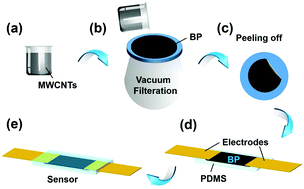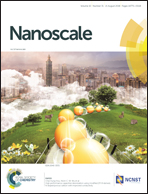High performance strain sensor based on buckypaper for full-range detection of human motions†
Abstract
A high-performance strain sensor based on buckypaper has been fabricated and studied. The sensor with an ultrahigh gauge factor of 20 216 can detect a maximum and a minimum strain range of 75% and 0.1%, respectively. During stretching, the strain sensor achieves a high stability and reproducibility of 10 000 cycles, and a fast response time of less than 87 ms. On the other hand, the sensor shows an excellent sensing performance upon pressure. The pressure range, pressure sensitivity and loading–unloading cycles are 0–1.68 MPa, 89.7 kPa−1 and 3000 cycles, respectively. A concept of the optimal value is utilized to evaluate the strain and pressure performances of the sensor. The optimal values of the sensor upon tensile strain and pressure are calculated to be 3.07 × 108 and 1.35 × 107, respectively, which are much higher than those of most strain and pressure sensors reported in the literature. Precise detection of full-range human motions, acoustic vibrations and even pulse waves at a small scale has been successfully demonstrated by the buckypaper-based sensor. Owning to its advantages including ultrahigh sensitivity, wide detection range and good stability, the buckypaper-based sensor suggests a great potential for applications in wearable sensors, electronic skins, micro/nano electromechanical systems, vibration sensing devices and other strain sensing devices.



 Please wait while we load your content...
Please wait while we load your content...